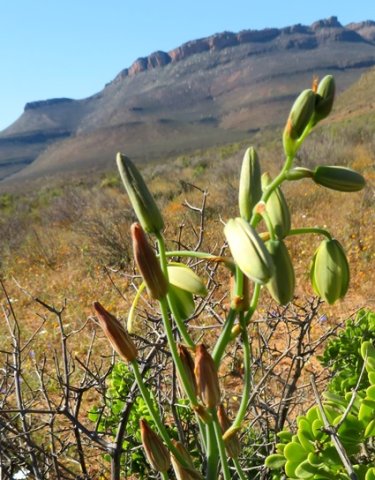Albuca

Albuca is a genus of bulbous perennials in the Hyacinthaceae family. Varying in size, the plants are usually deciduous, rarely evergreen, some forming clumps.
The mostly globose bulbs have layered tunics enveloping inner ones or overlapping imbricately, their tunic top ends membranous or fibrous.
One to many leaves grow with or after flowering. The leaf-shape is linear, cylindrical or strap-shaped, spirally twisted in a few species. Leaf bases are tubularly sheathed, the tips acute or tapering, the blades glabrous or hairy. These hairs are in some cases glandular.
Variable numbers of flowers grow in flat-topped or long and slender racemes on cylindrical, naked peduncles. The bract subtending each flower is lance-shaped, or oval and tapering to an acutely pointed tip.
The bisexual flower grows two whorls of three tepals each. The tepals are white or yellow with green or grey bands or keels down the centre. The oblong tepals are free and persistent. Outer tepals spread, inner ones remain together or spread, depending on the species. The inner tepals often have thickened, hooded or flap-like tips. Flowers may be erect, facing out horizontally, nodding or drooping. Pedicel length varies across species as does fragrance.
There are six stamens to a flower, the outer three sometimes sterile with deficient or no anthers. The filaments are cylindrical or winged, sometimes broad at the base. The superior ovary is three-locular and oblong to ellipsoid in shape, holding many ovules. The style on top is variously shaped.
The fruit is a three-angled, ovoid or globose capsule that opens per locule. The flat, semi-circular seeds are black and shiny.
There are about 80 Albuca species, 60 of which are found in southern Africa, while some occur as far away as the Arabian Peninsula. The habitat is grassland, thornveld or rocky outcrops, the plants often growing in sandy soils.
A few species feature in horticulture, some in traditional medicine. The vernacular name of many species is slime lily, while some are still called tamarak, the name persisting from Khoi or San languages.
The plant in picture is Albuca fragrans photographed in the Biedouw Valley (Leistner, (Ed.), 2000; Vlok and Schutte-Vlok, 2015; Manning, 2007).

